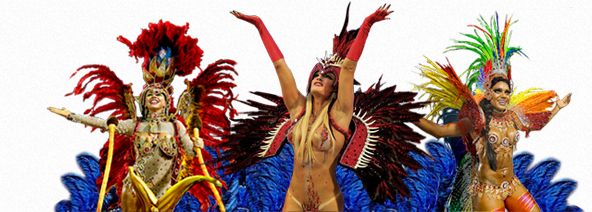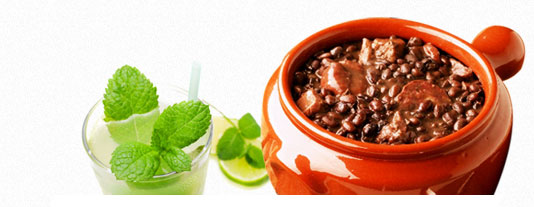Carnival
Carnival in Novi Sad
Dear admirers of Brazil and it's art, sports, music and dance, we are approaching a special, 10th year anniversary edition of Novi Sad's samba carnival!
Dani Brazila festival will celebrate it's 10th birthday with concerts, workshops and a carnival parade and all of that in Novi Sad between 23rd and 25th of August at the most attractive city locations, banks of the river Danube and on the Petrovaradin fortress!
The city will literally breath in the brazilian mode providing air for many passionate samba dancers, percussionists and capoeira dancers. Save the dates and prepare yourself to take part in this unforgettable international spectacle, the biggest of it's kind in this part of Europe!

Trivia
Carnival in Brazil
During the seven day period, Brazil, a country with over 190 million people falls into carnival trans when many samba schools, tourists and police officers gather on city streets and sambadromes to the sound of Samba, Axe and Micarete. Beer consumption in this period is 80% of all annual consumption, local authorities generously give away condoms and carry out campaigns about AIDS while older people proverbially claims that carnival is no longer what it used to be.
Although, indirectly, descended from European Carnival celebrations with a deep religious background, perhaps more like the Roman Saturnalia, the Brazilian carnival has a very authentic appearance and is created with a mixture of different musical styles and religious traditions of descendants of African slaves and European colonists. There are different styles of carnival in different parts of Brazil such as Bahia, Pernambuco, Minas Gerais, Sao Paolo, but the most famous carnival is held in Rio de Janeiro.
Carnival in Rio begins always on Sundays. Its main event is a carnival parade, in which the quality of costumes, musical arrangement and the general impression is being assessed, but there are also hundreds of samba groups, called blocos, performing in the neighborhoods they come from so the whole city turns into carnival.

Feijoada and Caipirinha
Although the above terms sound exotic and distant, to the average Serb they represent something close and daily. In fact it is beans (feijoada) and schnapps (caipirinja). Often served together, in Brazil they are considered as a national food and drink. Feijoada was brought to Brazil by Portuguese colonists, even though beans are an American plant. A special combination of ingredients was made in Brazil which divided Feijoada into Brazilian and Portuguese.
Brazilian Feijoada is made from black beans which are cooked on low heat in earthen vessels together with chopped beef, pork, smoked ribs… Alongside Feijoada as a main course, cabbage and broccoli salads are also served together with inevitable rise, farofa, oranges and fried bananas. Feijoada is a Brazilian national dish which is to say that everyone likes to eat it and that it is available to everyone equally.
In order to prepare the body for Feijoada one need to take a sip of Caipirinha before the meal. Caipirinha is made from Cachasa, fermented sugar liquor, lime and sugar, so it can be said that it is more of a Brazilian cocktail rather than schnapps as its name suggests. The basic recipe of Caipirinha contains 0.5cl of Cachasa, half of lime sliced into four pieces, two teaspoons of sugar and ice. This drink has become very popular outside Brazil where, instead of Cachasa, they use Vodka, Campari, Beirao, Sake…

Trivia
Samba
There are several theories about the origin of the word Samba. According to one of the theories, this term originates from the African Kikongo dialect and means navel blow while the other explaines it as a compound of Kimbundu dialects, Sem-ba, which means give-receive. What is certain is that the term was firs recorded in 1838 in the Carapuceiro journal where it was used in a negative context by the priest Miguel Lopez Gama.
In modern terms Samba represents modern Brazilian dance and a musical genre which originated, like most things in Brazil, as a mixture of African traditions and European and South American urban areas such as Rio de Janeiro, evolving from the ritual dance of black slaves to the means of cultural emancipation of Afro-Brazilians and symbols of Brazilian culture and global phenomenon which is a lot more than a naval blow.
Musical styles suh as Batuque, Polke, Maxixe, Lundua and Xote fused through 2/4 rhythm using instruments such as chocalcho, reco-reco, cavaquinho, surdo, tamborim, a-go-go and many others have created a musical form which, over time, absorbed new coming musical styles from jazz, funk, disco, rock to rap and pagode, showing that Aunties from Bahia, whose houses became the place of gathering at Samba rodas in the beginning of the twentieth century, spawned the most vital musical genre knowing that in the essence of everything it is still giving and receiving. As a main ingredient of Brazilian carnival, through performances of many Samba schools in the world, Samba with its popularity led to birth of organizations of Sambistas from Japan to Serbia and beyond turning into a movement which proves that people of all races and classes can play, sing and dance together in the spirit of Brazila as a symbol of hope for a better world.
Links
Tourist guide BrazilGuide for Rio de Janerio
Football World Cup - Brazil 2014
Olympic Games - Rio de Janerio 2016
Did you know?
Brazil produces the most oranges in the world.
Brazil shares a common border with all South American countries, except Ecuador and Chile.
Brazil's natural resources include bauxite, gold, iron ore, manganese, nickel, phosphates, platinum, tin, uranium, petroleum, hydropower and timber.
Brazil is the only Latin American nation that derives its language and culture from Portugal.
Seedless oranges were not grown in the United States until 1871. The first ones came from Brazil.
The world's widest road is the Monumental Axis in Brazil, where 160 cars can drive side by side.
Brazil covers nearly half of South America and is the continent's largest nation.
The smallest frog is the Gold frog of Brazil. It grows to only 9.8 mm.
Brazil nuts are rich in selenium, a potent antioxidant.
Over a third of Brazil is drained by the Amazon and its more than 200 tributaries.
The citizens of Rio de Janeiro, Brazil are called "Cariocas."
Of all the countries, Brazil has the most plant species, with over 56,000.
Of the 15,000 known species of orchids in the world, 3,000 of them can be found in Brazil.









